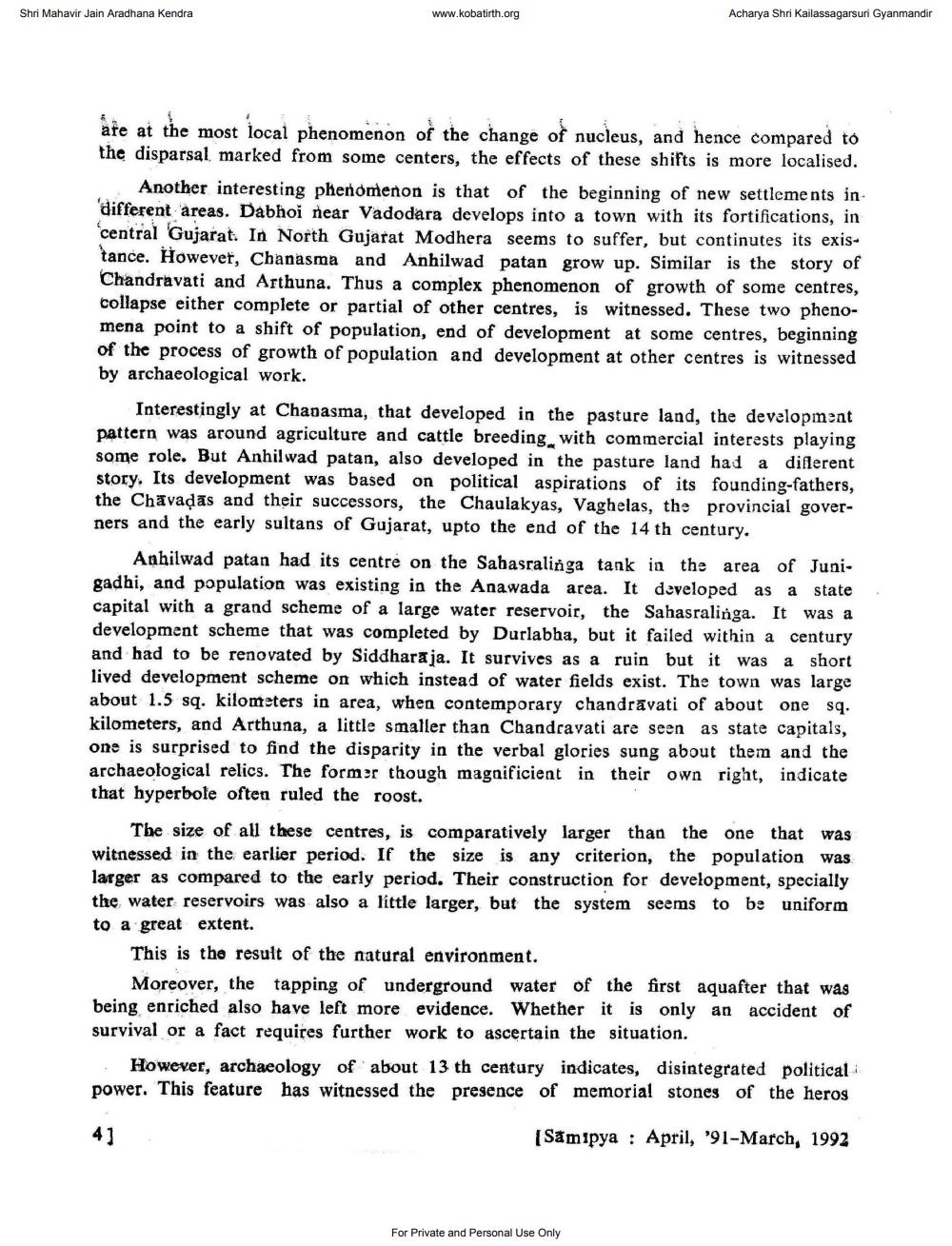Book Title: Samipya 1991 Vol 08 Ank 01 02 Author(s): Pravinchandra C Parikh, Bhartiben Shelat Publisher: Bholabhai Jeshingbhai Adhyayan Sanshodhan Vidyabhavan View full book textPage 6
________________ Acharya Shri Kailassagarsuri Gyanmandir Shri Mahavir Jain Aradhana Kendra www.kobatirth.org ate at the most local phenomenon of the change of nucleus, and hence compared to the disparsal marked from some centers, the effects of these shifts is more localised. Another interesting phenomenon is that of the beginning of new settlements in different areas. Dabhoi near Vadodara develops into a town with its fortifications, in 'central Gujarat. In North Gujarat Modhera seems to suffer, but continutes its existance. However, Chanasma and Anhilwad patan grow up. Similar is the story of Chandravati and Arthuna. Thus a complex phenomenon of growth of some centres, collapse either complete or partial of other centres, is witnessed. These two phenomena point to a shift of population, end of development at some centres, beginning of the process of growth of population and development at other centres is witnessed by archaeological work. Interestingly at Chanasma, that developed in the pasture land, the development pattern was around agriculture and cattle breeding, with commercial interests playing some role. But Anhilwad patan, also developed in the pasture land had a diferent story. Its development was based on political aspirations of its founding-fathers, the Chāvadās and their successors, the Chaulakyas, Vaghelas, the provincial governers and the early sultans of Gujarat, upto the end of the 14 th century. Anhilwad patan had its centre on the Sahasraliaga tank ia the area of Junigadhi, and population was existing in the Anawada area. It developed as a state capital with a grand scheme of a large water reservoir, the Sahasralinga. It was a development scheme that was completed by Durlabha, but it failed within a century and had to be renovated by Siddharaja. It survives as a ruin but it was a short lived development scheme on which instead of water fields exist. The town was large about 1.5 sq. kilometers in area, when contemporary chandravati of about one sq. kilometers, and Arthuna, a little smaller than Chandravati are seen as state capitals, one is surprised to find the disparity in the verbal glories sung about them and the archaeological relics. The former though magnificient in their own right, indicate that hyperbole often ruled the roost. The size of all these centres, is comparatively larger than the one that was witnessed in the earlier period. If the size is any criterion, the population was larger as compared to the early period. Their construction for development, specially the water reservoirs was also a little larger, but the system seems to be uniform to a great extent. This is the result of the natural environment. Moreover, the tapping of underground water of the first aquafter that was being enriched also have left more evidence. Whether it is only an accident of survival or a fact requires further work to ascertain the situation. However, archaeology of about 13 th century indicates, disintegrated political power. This feature has witnessed the presence of memorial stones of the heros 41 Sámipya : April, '91-March, 1992 For Private and Personal Use OnlyPage Navigation
1 ... 4 5 6 7 8 9 10 11 12 13 14 15 16 17 18 19 20 21 22 23 24 25 26 27 28 29 30 31 32 33 34 35 36 37 38 39 40 41 42 43 44 45 46 47 48 49 50 51 52 53 54 55 56 57 58 59 60 61 62 ... 134
